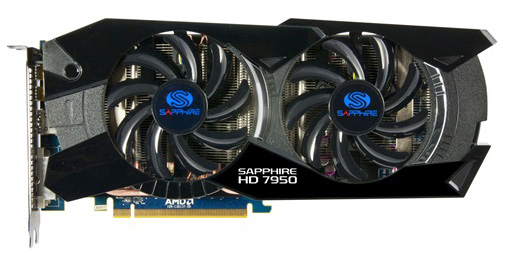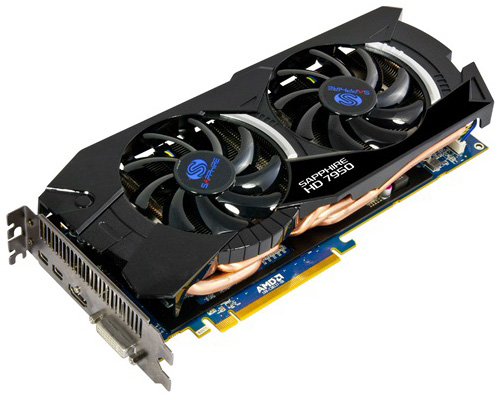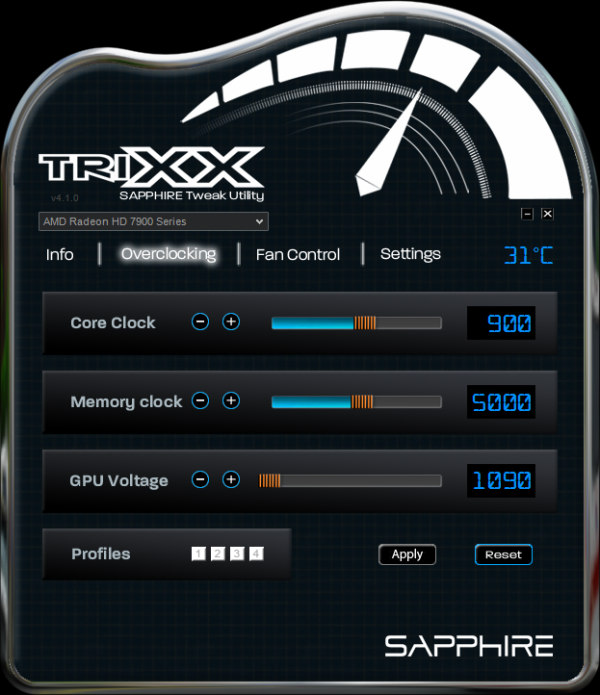AMD Radeon HD 7950 Review Feat. Sapphire & XFX: Sewing Up The High-End Market
by Ryan Smith on January 31, 2012 9:02 AM ESTMeet the Sapphire HD 7950 Overclock Edition
Since our reference 7950s are built on the 7970 PCB and cooler, we’re going to jump right into our vendor cards starting with the Sapphire HD 7950 Overclock Edition.
As with all of the 7950 cards launching today, Sapphire’s HD 7950 Overclock Edition uses the AMD 7950 PCB. This is a slightly shorter PCB measuring 10.25” long, saving .25” over the 7970 PCB by eliminating a few components that the lower board power of the 7950 makes unnecessary. The PCB is otherwise very similar to the 7970 PCB, utilizing 12 GDDR5 memory chips organized around the Tahiti GPU, while at the top you’ll find the 2 CrossFire connectors, a pair of 6pin PCIe power sockets, and the BIOS selection switch. The latter will be of particular interest to unlockers, as the switch should make it possible to safely attempt to unlock the 7950 into a 7970.

Moving on, as this is a semi-custom card the real differentiation is in the factory overclock and the cooler. On the performance side of things Sapphire will be shipping the 7950 Overclock Edition at 900MHz core and 5GHz memory, representing a 100MHz (12.5%) core overclock and no change on the memory clock.
Meanwhile for the cooler Sapphire is using what they’re calling the Dual-X cooler. The Dual-X is yet another double-wide dual-fan open air cooler, with 2 fans providing copious airflow over an aluminum heatsink running virtually the entire length of the card. Sapphire’s fan cutouts are just a bit bigger than most other dual-fan coolers and placed a bit higher, and as a result the Dual-X cooler is a bit taller than the PCB by about 15mm at its highest point. Meanwhile the cooler is also a fair bit longer than the PCB, putting the total card length at 11”.
Moving below the fans and the heatsink we’ll find the heatpipe assembly, which is responsible for carrying heat from the GPU to the heatsink. The Dual-X uses 5 copper heatpipes of varying radius that run from one end of the heatsink to the other. The 5 heatpipes converge at the base of the assembly, where a copper baseplate provides contact with the GPU. Meanwhile cooling for the VRM MOSFETs and RAM is provided by a black aluminum plate, which is placed over those components with heat transfer provided by the use of thermal pads. There is no connection between the plate and the heatsink, so the only heat dissipation from the plate is provided by whatever airflow from the fans reaches the plate.

At the front of the card we’ll find the display ports, which as this is an AMD PCB the card utilizes the standard AMD 7000 series port configuration of 1 DL-DVI port, 1 HDMI port, and 2 mini-DisplayPorts. Filling out the second slot is the grating for ventilation, though even with the ventilation slot the usual precautions for an open-air cooler apply: you’ll need a case with enough airflow to handle the roughly 200W of heat the card is capable of dumping inside of your case.
Rounding out the package is the usual collection of dongles and materials. Sapphire includes 2 molex-to-6pin PCIe adaptors, an HDMI to DVI dongle, a miniDP to DisplayPort dongle, a DVI to VGA dongle, and a 1.8m HDMI cable. Along with the dongles Sapphire packs a quick start guide and a driver installation CD.
The only thing you won’t find packed in the box is TriXX, Sapphire’s in-house overclocking utility. TriXX has been around since the 6900 series, but as this is the first high-end Sapphire card we’ve reviewed since it was released, this is the first time we’ve had it available for a review.
Fundamentally TriXX is a fairly well designed, albeit barebones overclocking utility. Along with an info readout similar to GPU-Z, TriXX provides overclocking and fan control support for Sapphire’s cards, including support for custom fan profiles and more importantly voltage control. With TriXX it’s possible to overvolt most of Sapphire’s performance and high-end cards, and as Sapphire uses AMD reference PCBs it also works with any other cards using AMD’s PCBs.
Beyond these features there’s little more to TriXX. It’s not an all-encompassing video card utility like MSI’s Afterburner, which means it comes up short if you need more functionality but it's exactly what you need if you just want to overclock. To that end it’s a clear step up compared to most other manufacturer’s poorly designed utilities, and from a design perspective its only real sin is the hard to read blue-on-black text. Otherwise it’s a competent overclocking utility that does exactly what it’s supposed to and provides voltage control for those who need it.
Finally, Sapphire will be selling the 7950 OE for $479, $30 over the baseline 7950 MSRP. Meanwhile the warranty on their card is their standard 2 year warranty.















259 Comments
View All Comments
Galidou - Sunday, February 5, 2012 - link
Oh wait, wait, the 9800gx2 was priced 150$ lower than the GTX 280 and was performing more than gtx 280!! LOL speak about mispricing.... LOL OMG THAT'S RIDICULOUSGalidou - Sunday, February 5, 2012 - link
LOL that 7970 story pricing like it was the worst decision a Video card manufacturer ever made is so ridiculous chizow, it'S not a good decision either, we would all like to see lower prices considering we know the size of the die under the hood and we know it can be priced lower.But that GTX 280 thingy because Nvidia was thinking they had no competition was a little like taking people for DUMMIES. The radeon 4870 wasn't so mispriced, it was the gtx 280 that WAS. The GTX was uber big but didn'T justify over triple the price of 8800gt or higher price than a 9800gx2 considering the performance of those parts..... HELL NO.
In the end, I prefer a pricing according to performance than being taken for a DUMMY by a company leading the technology with a little more performance...
chizow - Sunday, February 5, 2012 - link
Like I said Galidou, the GTX 280 absolutely earned the original MSRP. It was a true flagship card in every respect and maintained the price:performance increase you would expect from a new next-gen GPU over its predecessor.You still haven't refuted this because again, the data is all out there. It was over 1.5x faster than the 8800GTX/9800GTX and roughly the same speed as the 9800GX2, the minimum baseline expectations anyone should have for a new flagship card on a new arch/gen/process.
AMD was the one who mispriced their card at the time they could least afford to do so. Some like myself argued they just didn't know how to make money. They could've easily priced it at $400 and STILL forced Nvidia to drop prices on the GTX 280 and especially the GTX 260.
But yes, Nvidia looked horrible after that decision but did right by their customers by issuing rebates. Now AMD is in the exact same position and stands to look badly with this pricing. Do you really think they will do the same if Nvidia forces them to cut prices on these parts? Its OK, you can say a bad thing about AMD too. ;)
chizow - Sunday, February 5, 2012 - link
We've already covered this, because with the exception of very rare and extraordinary increases like the 8800GTX or 9700pro, 2x increases over last-gen flagships are NOT normal.The GTX 280 was easily 2x faster than the 8800GT, but the 8800GT was a refresh mid-range performance product. Whatever price:performance discount it carried already existed compared to the high-end parts of the time like the 9800GTX and 9800GX2, where it cost significantly less for excellent performance.
Similarly, in these last few generations of cards mid-range cards like the GTX 460 and GTX 560 can be had for less than half of what a GTX 480 or GTX 580 cost but they perform much better than the cost would indicate. Obviously the top Kepler does not need to be 3x faster than the GTX 560 in order to command a $500 price tag commensurate with the flagship slot.
In summary, the top cards do command a premium and determine the pricing for all cards that follow, but their merit for commanding that top price is judged against previous cards and generations.
Its already become obvious that 15-25% increase from Tahiti over Fermi doesn't carry enough mustard to push the stack, since its momentum wasn't enough to even shift the metric at the second stop, the 7950.
Galidou - Sunday, February 5, 2012 - link
It was the same performance than a 9800gx2 when it was in 2560* resolution because of memory, for the rest(99.5% of the people with 1080p or less back then) the 9800gx2 was truncating the gtx280 for 150$ less.chizow - Sunday, February 5, 2012 - link
No it was trading blows with the 9800GX2 and beating it at the highest resolutions and AA settings that mattered for people looking to upgrade.This is going to happen with any new flagship part because of the overall increased pipeline. High-end cards are meant to push high-end settings and resolutions because what you have is usually enough at lower end settings. This is why we "upgrade".
Regardless, X2 parts are always going to carry some performance advantage at cheaper prices but that's because single-GPU always carries a premium that goes with being the top single-GPU flagship.
You can look at any forum and you see this decision making process all the time with both last-gen GPUs and newer ones.
But back to the point. Flagship next-gen GPUs do generally tend to compete with last-gen X2 in performance, not always a convincing win across the board, but enough to effectively retire those cards. That's clearly not the case with the 7970.
Galidou - Sunday, February 5, 2012 - link
Nope you still can,T say something wrong about Nvidia you corrected them by saying they issued rebates to their customers, and AMD is not in the same position, they did not price it for dummies, it'S accordingly to it'S performance... wow when will you realize triple the price and according to it'S performance is different? that's all I wan you to say lol!chizow - Sunday, February 5, 2012 - link
Is the 7970 triple the performance of the 6950? So then how does it justify 3x the price?Its amazing how you want to try to hold Nvidia to this flawed logic and dismiss it when the 7970 fails even WORST at meeting it.
Again, this just makes you look incredibly stupid or incredibly dishonest, neither of which are flattering.
Galidou - Sunday, February 5, 2012 - link
it'S not triple the price of 6950 it's a LITTLE more than double, fi you have to lie this discussion is over..... when I said triple the price of the 8800gt I was gentle, 650$ for gtx 280 while 8800gt were selling for I remember I got one for 180$ so that's in fact three times and a half, plus we're comparing a 1gb video card price to a 3gb while GTX 280 and 8800gt had 256mb difference.... Now that I see you have to lie I don't want to continue this, I may be not right in EVERYTHING I say but I ain't lying big time....I prefer to be honest in my opinion than being dishonest in a certitude.....
Ati radeon 3870 sucked big time, they never offered as good a competition to Nvidia after the X1xxx products in my opinion and Nvidia have(most of the time) got better drivers, I prefer their interface, I dislike catalyst. Here's what I have to say about ATI and I have not much wrong about Nvidia but at least I can say I see both side of the medal.
Good luck in the future, peace out.
Galidou - Sunday, February 5, 2012 - link
I was offering you my perception ok I played the troll but I never lacked respect to you, I'm not saying you are stupid or anything while you did, respect is something you can't buy.I may be poking your opinions because you see them as fact but thing is perception is different for everyone. I do not see anything SO wrong in the pricing of the 7970 while you obviously see something very bad in it. I can'T make you see my point of view so I guess you and I are right, depends for who reads us.
respect.